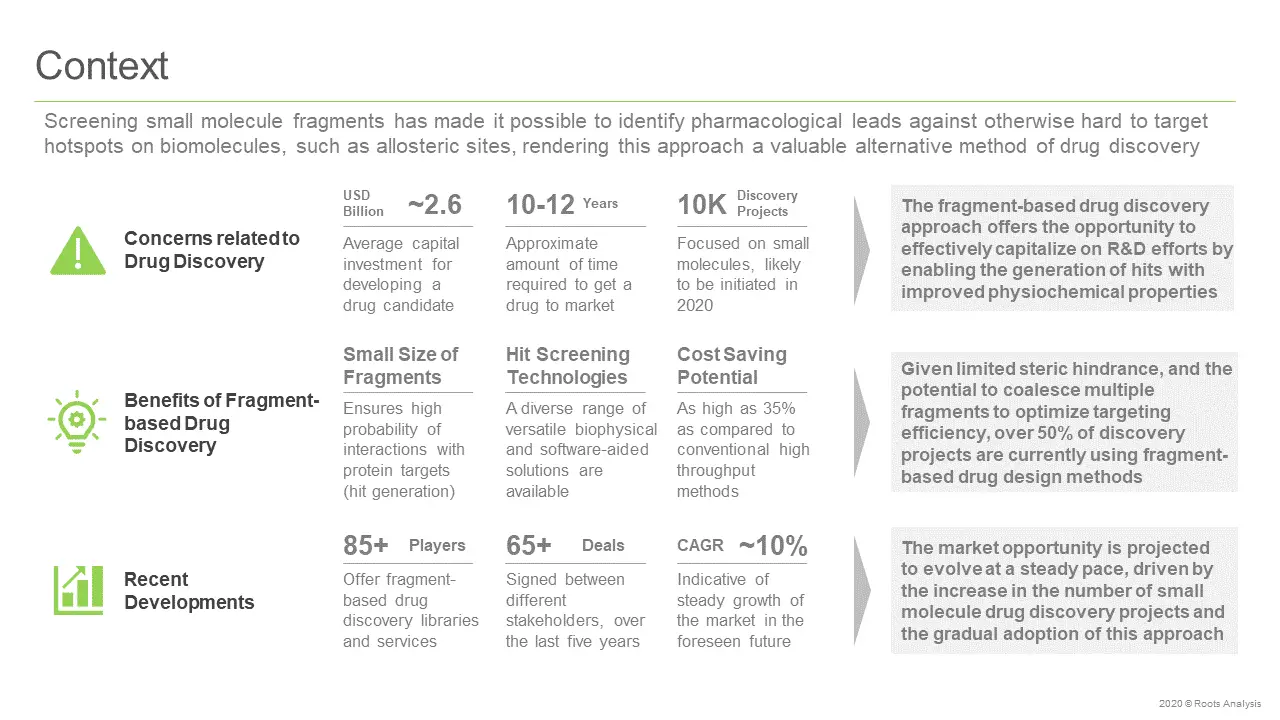To order this 170+ page report, please visit this – https://www.rootsanalysis.com/reports/view_document/fragment-based-drug-discovery/309.html
Key Inclusions
- A detailed review of the overall landscape of fragment-based drug discovery library and service providers along with the information on type of product (library and technology), type of service offered (fragment screening and fragment optimization), type of technique used (X-ray crystallography, nuclear magnetic resonance, surface plasmon resonance, and other screening techniques), other services offered (target identification / validation, hit identification, hit-to-lead / lead generation, lead optimization), and end user (industry, academia, and contract research organizations).
- Elaborate profiles of the companies providing libraries and services for fragment-based drug discovery (shortlisted on the basis of the service portfolio and number of fragment screening techniques offered). Each profile features a brief overview of the company, its financial information (if available), fragment-based library and service portfolio, information on other drug discovery services, recent developments and an informed future outlook.
- An analysis of the partnerships that have been established in the recent past, covering R&D collaborations, mergers and acquisitions, product development and commercialization agreements, commercialization agreements, distribution and supply agreements, product integration agreements, service agreements, and other relevant types of deals.
- A detailed analysis on acquisition targets, taking into consideration the historical trend of the activity of the companies that have acquired other firms since 2015, and offering a means for other industry stakeholders to identify potential acquisition targets.
- An insightful competitiveness analysis of fragment-based drug discovery library and service providers, based on supplier power (based on the years of experience of service provider) and key specifications, such as number of fragment libraries and number of screening techniques.
- An analysis highlighting the cost saving potential associated with the use of fragment-based drug discovery approach.
- Informed estimates of the existing market size and the future opportunity for fragment-based drug discovery library and services, over the next decade. Based on multiple parameters, such as annual number of drug discovery projects, outsourcing profile, and adoption of fragment-based drug discovery approach, we have provided informed estimates on the evolution of the market for the period 2020-2030.
The report features the likely distribution of the current and forecasted opportunity across important market segments, mentioned below:
- Type of Screening Technique Used
- X-ray Crystallography
- Nuclear Magnetic Resonance
- Surface Plasmon Resonance
- Other Screening Techniques
- Type of Service Offered
- Library Screening
- Fragment Screening
- Fragment Optimization
- End User
- Industry Players
- Non-Industry Players
- Key geographical regions
- North America (US and Canada)
- Europe (UK, France, Germany, Spain, Italy, and rest of Europe)
- Asia-Pacific (China, Japan, India, and rest of Asia-Pacific / rest of the world)
The report also features inputs from eminent industry stakeholders, according to whom the fragment-based approach significantly simplifies the drug discovery process. The report includes detailed transcripts of discussions held with the following experts:
- Jean-Yves Ortholand (Co-founder and Chief Executive Officer, Edelris)
- Björn Walse (Chief Executive Officer, SARomics Biostructures)
To request sample pages, please visit this – https://www.rootsanalysis.com/reports/309/request-sample.html
Key Questions Answered
- Who are the leading players in the fragment-based drug discovery library and services market?
- What are the key biophysical techniques used by service providers for screening fragment libraries and lead optimization?
- Which types of partnership models are commonly adopted by stakeholders in this domain?
- What is the likely cost-saving opportunity associated with the use of fragment-based drug discovery?
- How is the current and future market opportunity likely to be distributed across key market segments?
For more information, please click on the following link:
https://www.rootsanalysis.com/reports/view_document/fragment-based-drug-discovery/309.html
You may also be interested in the following titles:
- DNA-Encoded Libraries: Platforms and Services Market
- Antibody Discovery: Services and Platforms Market (2nd Edition), 2018-2028
- In Silico / Computer-Aided Drug Discovery Services Market: Focus on Large Molecules (Antibodies, Proteins, Peptides, Nucleic Acid, Gene Therapy and Vectors), 2020-2030 (Including Structure Based Drug Discovery, Fragment Based Drug Discovery, Ligand Based Drug Discovery, Target Based Drug Discovery, Interface Based Drug Discovery Approaches)
Contact Information
Roots Analysis Private Limited
Ben Johnson
+1 (415) 800 3415
Facebook – https://www.facebook.com/RootsAnalysis
LinkedIn – https://www.linkedin.com/company/roots-analysis/mycompany/
Twitter – https://twitter.com/RootsAnalysis
Medium – https://medium.com/@RootsAnalysis
Pinterest – https://in.pinterest.com/RootsanalysisPin/_saved/
Quora – https://rootsanalysisinsights.quora.com/
0






